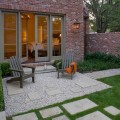Formal Garden Plants
The spacing of formal garden plants is vital to the success of all formal designs. Carefully spaced rows are often arranged in varying heights to promote the idea of order and symmetry. Rows also help support the idea of linearity which is used in many formal garden designs, such as the French and the Italian.
Plants closest to the center tend to be taller, with the largest formal gardens sometimes even having trees growing around the center. As you move away from the center and plants get smaller, this creates an optical illusion of a garden that is much larger than it really is.
It also helps lend a sense of stability to the entire design, because with taller plants at the center, the focal point of greater height tends to function as a visual anchor point to the senses.
Formal garden plants are planted in key positions in order to create the many complex designs that make up this style. In many instances, a mirroring effect is also created, where one side of the garden directly reflects the other side. This way, when you view the garden from a certain vantage point, such as a balcony or upstairs window, you see twin images complimenting each other.
Even when this reflection factor is not present, repetition is present in every formal garden design. Formal garden plants are arranged in patterns that occur over and over again along linear axes, and also in other geometric forms based on arcs and radii. Combined, these patterns interweave and interlock to create complex layers of varying shades of green and, in some styles, many different colors planted in blocks throughout the design.
Evergreens are the most common of all formal garden plants. This is because foliage matters more than flowers in formal garden design. Plants that retain their foliage year round offer two advantages. For one thing, they create a continuous and consistent field of greenery. Secondly, different species of evergreen invariably present more than one shade of green.
When properly spaced and arranged in relationship to one another, all manner of shrubs, hedges, and even trees can be used to create multiple layers of green color in lieu of the stereotypical color patches more common to standard flower gardens.
This is not to say that flowering plants are not used in formal gardens. They are simply secondary in nature to green vegetation, and they are typically used to create zones of interest, accent, or focal points in key places. Flowering plants are usually arranged in beds and are consistent as a single color of choice. This presents an even presentation of color and a clear, definitive shape that is immediately recognizable to the eye.
Focal points can be established by using species that lend themselves well to strong architectural outlines. Depending on the style and size of the garden, these species can be anything from tall growth, standard in height, or low level ground cover.
A few examples include yew, privet, hornbeam and conifers (tall growth) and lavender, rosemary, ligustrum, and topiary for small hedges. Standard formal garden plants also include such species as roses, wisteria, and lavender.

